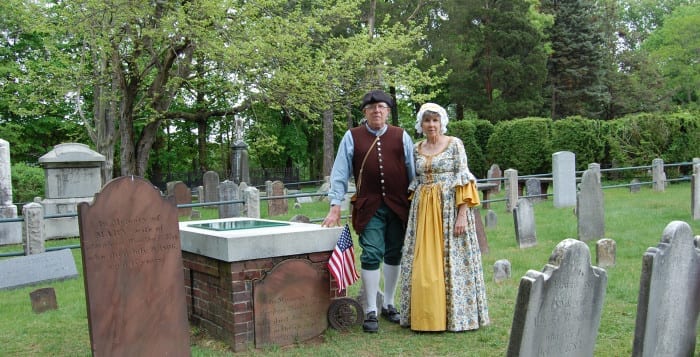Culper Spy Day highlights our Revolutionary War history

By Barbara Russell
“By the 29th inst I expect to hear further from C_; his Dispatches shall be duly forwarded I would take the liberty to observe that a safe conveyance may be had, by the bearer, for the ink which your Excellency proposed sending to C_”
The writer was Setauket native Col. Benjamin Tallmadge, and the letter was sent to General George Washington July 25, 1779. Tallmadge is assuring the general that he is expecting information soon from C_, alias Samuel Culper, alias Abraham Woodhull, and is referring to an invisible ink provided by Washington to be used by members of the Culper Spy Ring.
Born in Setauket in 1754, Benjamin Tallmadge left Setauket as a teenager to enter Yale College, became a school teacher after graduation, and subsequently joined the Patriot forces. He served as the chief intelligence officer for General George Washington and relied on his childhood friends from Setauket for the intelligence reports so vital to Washington’s success.
The Culper Spy Ring is not a tale but a real and factual account of spying during the American Revolution. Its epicenter was nestled right here in Setauket. Benjamin Tallmadge, Abraham Woodhull, Austin Roe and Caleb Brewster all lived here and knew each other growing up. Tallmadge leaned on his trusted friends to create the web that brought information from New York City out to Long Island and across the Long Island Sound to him in Connecticut. From there, it was transmitted to General Washington.
Spying is very risky, and every person involved knew it. All but Caleb Brewster used fictitious names; invisible ink was provided; a dictionary of code words invented; and success depended on trusting that each person was committed to the fullest. The Culper Spy Ring operated from 1778 through 1783, with additional agents beyond the Setauket friends. One known agent was Robert Townsend of Oyster Bay, who had a business in New York City, allowing him to pick up information on British troop strengths and movements and then pass it on to either Austin Roe, an innkeeper, or Abraham Woodhull, a farmer and business operator. Both traveled to New York City in the course of their businesses.
The residents of Brookhaven attempted to carry on with their lives, while British soldiers were assigned to the Setauket area, following the disastrous Battle of Long Island in August 1776. Town board minutes of the time do not refer to the war but to the general running of a municipality with tax collecting, electing officials, land ownership, and responsibility for the indigent. Newspapers of the time did report unpleasant raids and indignities imposed on the residents. In December 1776, William Tryon, provincial governor of New York, traveled to Setauket to secure the support of Brookhaven residents for his majesty’s government.
Eight hundred one men pledged their support for the British Crown on the Setauket Village Green, then Brookhaven’s central meeting place. Among the signers was Abraham Woodhull, perhaps a move that would reduce suspicion for his intelligence work. Some residents, who feared for their safety, did flee to Connecticut, and remained for the duration of the war. Those who stayed were subjected to British occupation, often having soldiers billeted in their homes, and their livestock and crops seized for use by the British.
Woodhull and Roe continued to live in Setauket throughout the war years, settling into their occupations and carrying on their intelligence work, probably not without fear of being discovered. Brewster, a determined and fearless man, made many trips across Long Island Sound to support the Patriot cause but never returned to Setauket to live. Tallmadge owed the success of his intelligence work to his friends and likely to others whose names are still unknown or unconfirmed.
Although the information about the Culpers was publicized over 80 years ago by former Suffolk County historian, Morton Pennypacker, it has received national attention in the last 10 years. Its rightful place among the history of the American Revolution was aided by the publication of “Washington’s Spies: The Story of America’s First Spy Ring” by Alexander Rose in 2006, “George Washington’s Secret Six: The Spy Ring That Saved the American Revolution” by Brian Kilmeade and Don Yaeger in 2013 and the AMC series “TURN,” now in its second season. And it all happened here.
Lucky is the child who listens to a story from an elder and cherishes it for years. Margo Arceri first heard the Culper Spy Ring story from her Strong’s Neck neighbor and local historian, Kate W. Strong in the 1970s.
“Kate W. Strong, Anna Smith Strong’s great-great-grandaughter, originally told me this story as a child when I used to visit her with my neighbor and Strong descendant Raymond Brewster Strong lll,” said Arceri. “She wrote for The Long Island Forum ‘The True Tales of the Early Days on Long Island.’ One of her stories was about Nancy [Anna Smith Strong’s nickname} and her magic clothesline. That’s where I first heard about the Spy Ring and my love grew from there.”
Today Arceri runs Tri-Spy Tours to share her knowledge of George Washington’s Long Island intelligence during the American Revolution. Her perseverance has inspired the upcoming Culper Spy Day — Our Revolutionary Story, on Saturday, June 20.
Barbara Russell is the Town of Brookhaven’s historian.






